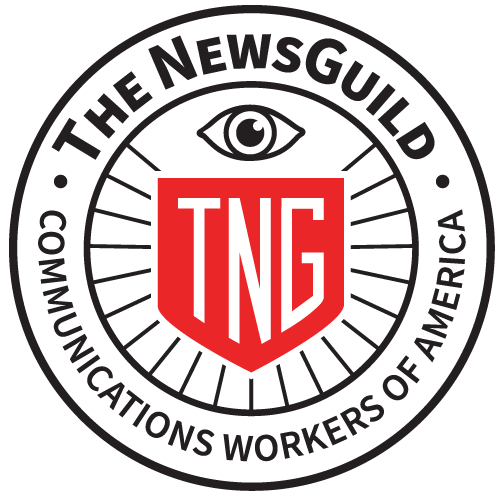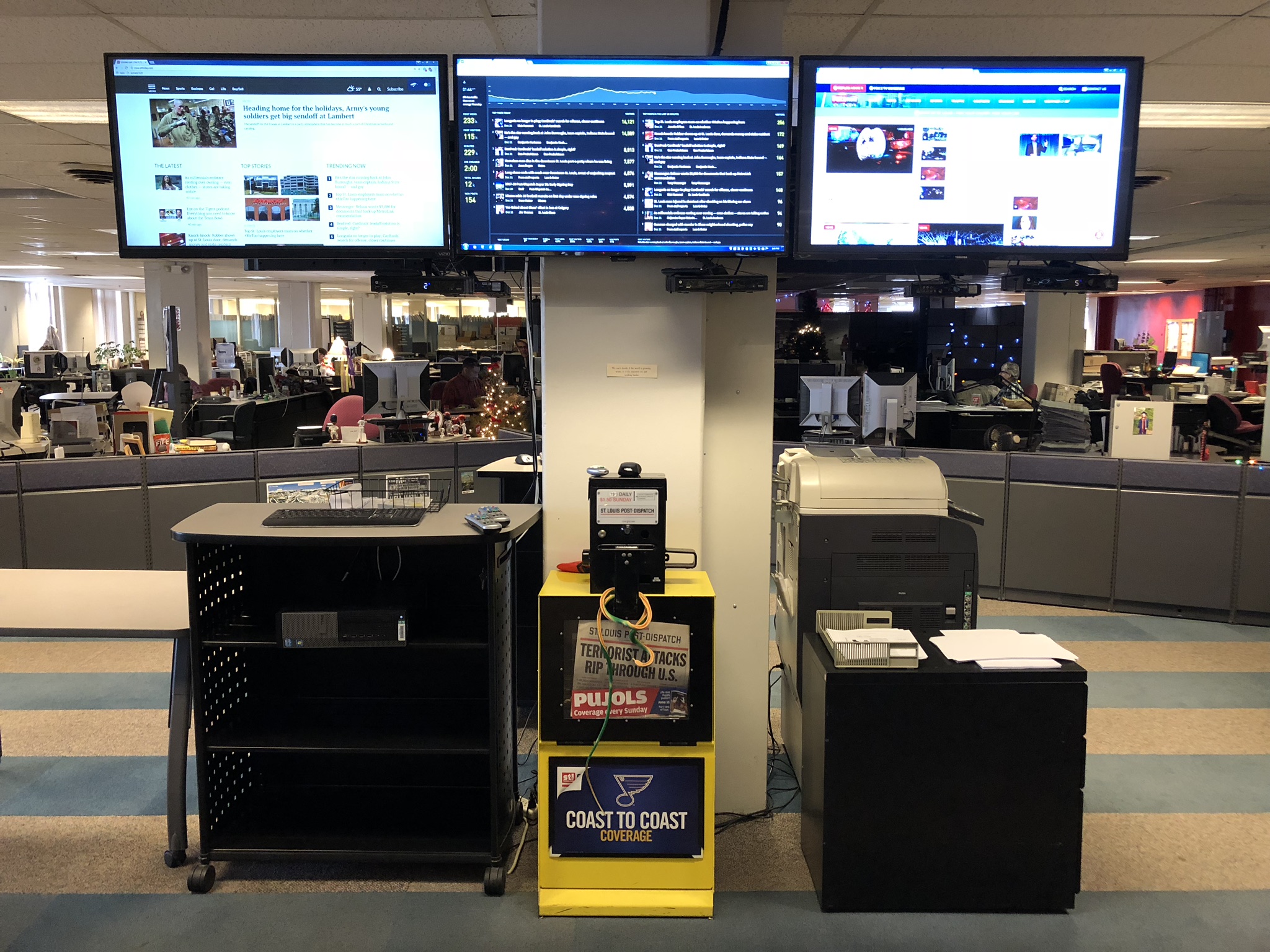By Martha Waggoner, NewsGuild International Chairperson
Jan. 16, 2018 – When sports reporter Jeff Gordon arrives at the office of the St. Louis Post-Dispatch, the first thing he sees as he gets off the elevator is a monitor that lists stories based on their popularity or the clicks they receive.

And while the newspaper and its unionized newsroom don’t have any official click – or page view – goals, everyone wants their story at the top of the list.
“Every week, we get our Google analytics report,” says Gordon, president of United Media Guild, which represents workers at the Post-Dispatch, owned by Lee Enterprises. “It isn’t anything that’s direct pressure or quotas, but it’s always there – come up with things that are strictly designed to drive traffic.”
In interviews with The NewsGuild-CWA, reporters at union and non-union newspapers across the country talked about how page goals increase stress and kill morale. Many spoke anonymously for fear of discipline or of losing their jobs if they publicly criticize their newspapers’ obsession with page view goals.
They complain of goals that are too high and require too many stories, given the severely reduced size of newsroom staffs. And they say the goals hinder quality journalism because reporters focus on stories that will get a lot of hits, such as one with a tangential connection to a celebrity or one that includes photos of pets. In the meantime, reporters say they’re abandoning or being told to abandon beats that don’t come with a deep readership, such as prisons or certain neighborhoods.

It would be easy to assume that those neighborhoods no longer under the scrutiny of a beat reporter are low-income ones. But reporters say they’re also walking away from beats from well-to-do towns, commissions and boards because those areas are so financially comfortable that they stir up little controversy – and therefore, stories about them generate few clicks.
The move is a sea change for reporters who believe they should attend every meeting of a board or commission, even if only to observe, says a reporter at a McClatchy paper. A journalist’s presence can encourage local officials to play by the rules. Such appearances also help with source-building, but editors don’t encourage attending those meetings unless a story is likely to materialize from them.
“You constantly have to be producing stories,” the reporter said. “Some stories might take you longer but get you a lot of traffic. But you take time from chipping away at that larger story to write smaller stories to keep you on track. If your goal is 300,000 (page views) a month, then you can’t spend a whole month on a story that yields 100,000 clicks and say ‘well, I tried.’”
Some reporters say their newspaper uses goals in the right way – to delve into readers’ habits, find what they’ll read and present stories that appeal to the audience and are educational.
“If reporters and managers are smart, they are going to use these metrics to our advantage,” said Anne Saker, staff writer at the Cincinnati Enquirer, a Gannett-owned newspaper. “We’ve never had such good metrics of what people are reading, when.”
She points to the Enquirer’s wall-to-wall coverage of Fiona, the baby hippo born at the Cincinnati Zoo who has her own page on the newspaper’s website. While readers may click on the stories, photos and video because she’s cute, they also get a dose of information about biodiversity, conservation science and the bottle-feeding of Fiona, Saker says.
She looks at places like McClatchy newspapers, where she has friends, and wonders about their future. “I don’t know if we have the answers,” she said. “But I like our answers better than other answers. … I’m quite bullish on where journalism can go if we don’t lose our nerve. I think places like McClatchy have lost their nerve, and they’re just managing the crash. We all are, but some are managing gravity better than others.”
Reporters at other Gannett newspapers, however, say they’ve heard talk that pay is docked at some non-union papers if reporters don’t meet their click goals. The rumor was so strong that Guild-covered reporters at the Knoxville News Sentinel questioned a Gannett executive about it in October.
“We asked statewide leadership point-blank at a meeting last month whether this was happening at non-union Gannett papers, and VP Michael Anastasi said he was certain it was not,” a reporter said.
A Gannett spokeswoman did not return emails seeking comment on the chain’s use of metrics.

Some newspaper leaders are using metrics wisely, says Ken Doctor, media analyst for Newsonomics, who singles out the Washington Post for the smartest use of metrics. Editor Marty Baron has made sure the Post doesn’t simply measure how many stories a reporter produces or how many page views he or she gets but is “also trying to understand how the story engages their readers, especially their subscribers,” Doctor said.
Freddy Kunkle, a Washington Post reporter and unit chair for the Washington-Baltimore local, recognizes the inevitability of metrics. But it’s still difficult to use them fairly, he said.
“Every reporter would love to have the words ‘Trump’ and ‘Kardashian’ in the same story all the time,” he said. “That said, I think The Post has been shrewd in its use of metrics. We do look not just at page views or unique visits but engagement – how long a person has stayed with a story – to gauge what works and what doesn’t.”
The union hasn’t heard of crude metrics being used in staff evaluations, to some extent because the collective bargaining agreement requires management to negotiate their use in that way, he said. “Yet we also hear from time-to-time from staff members that the pressure to yoke metrics to performance evaluations – and perhaps to rewards and punishments – is there, at least lurking in the background,” Kunkle said.
In addition, The New York Times is one of the few papers that connect page consumption to its subscribers, Doctor said.
Newspapers that analyze scroll depth – how far into a story did a reader read before moving on to another story – and that focus on subscribers are the ones using metrics correctly, he said.
Used bluntly, metrics are of no use, he said. And it’s not surprising that some chains are using “this much-too-basic method,” to decide the direction of their newspapers.
Let’s say there’s a tangential local angle to a story about a Kardashian. It likely will get lots of page views. But it’s less likely that subscribers will read it, while “a local story of some meaning might have a significant readership among paying subscribers,” Doctor said. “That’s more important.”
Newsroom managers, for the most part, are struggling to find a money-making model for quality journalism, not to make reporters’ lives miserable.
“Newsroom reinvention” is how McClatchy describes its use of click goals as a way to produce “journalism that makes a difference in our communities and resonates with our readers,” said Tim Grieve, the chain’s vice president for news.
“As journalists, we all want our work to be read,” Grieve wrote in an email. “And our work has to be read for us to have the impact we want – to hold leaders accountable and to make our communities better.”
And that’s why McClatchy set “digital readership targets” for reporters, he wrote. McClatchy is confident that reporters will have no problems meeting those targets if they’re on the right beats
“and if the reporters and editors are following the best practices of newsroom reinvention.”
But reporters at McClatchy newspapers say they’re overwhelmed with the pressure of meeting these goals. Some editors have told reporters that they don’t believe the reporters can meet the goals, and no one seems to know what the consequences are if they fall short. If your goal is 800,000 clicks a year, is 700,000 enough to keep your job?
“There’s a lot of high and mighty talk about speaking truth to power,” a McClatchy reporter said. “But it’s impossible to find time for everything. … The pace right now is relentless and exhausting.”

For the first time, click goals have become an issue in bargaining at a NewsGuild-covered newspaper. McClatchy hasn’t provided any specific contract language at the Sacramento Bee yet – their proposal just says that salary will align with newsroom reinvention and that they’ll introduce metrics to annual performance reviews, said Ed Fletcher, the unit chair at the Bee.
“There’s a high level of concern among a number of people,” Fletcher said. “Some of the factors that determine whether a story does well online are outside the scope and control of reporters – what time it’s posted, where it’s posted, when it’s posted on Facebook and what it’s up against.”
“High click rates don’t equate to quality journalism, and metrics are not the solution to the problems plaguing the industry,” said NewsGuild President Bernie Lunzer. “What sells journalism is quality reporting and credibility. That’s what we must strive for.”
Some newspapers stumbled with metrics when they were first introduced but have improved since. A Cox newspaper reporter says journalists there “found themselves writing stories to pad their numbers” in the first year of metrics but have gotten away from that since then.
“We get directives from editors – this will get good hits on the website,” the reporter said. “That was a little different and disturbing to me – it’s weird to hear somebody pitch a story for web hits and not for quality. There was a story last year that a colleague didn’t want to write, but it was guaranteed pay dirt.”
Back in St. Louis, the Post-Dispatch has added a “sweeps month,” where there’s an increased emphasis on meeting click goals, Gordon says. The easiest trick is a slide show, where readers click through slides accompanied by more ads than stories typically have.
Meanwhile, resources go to filling positions such as web producer or audience engagement specialist. “Those resources are not going to add a statehouse person or build an investigative team,” he says. “That’s been whittled away.”
At the same time, sales people “are being subjected to horrendous pressure,” he says. “They’re still making a lot of money off print, but they live and die off bringing money to digital. They’re just desperate to be able to do that. And it’s not happening.”
Newspapers focus on metrics to help sell ads, Doctor says, but newspaper leaders must know what the numbers mean.
“It’s not a one-to-one relationship,” he says. “If you give me 1,000 page views on one story compared to 100 on something else, that’s not necessarily going to mean 10 times the value to the business,” he said. “Are those local views? Are they subscriber views? Or are they one-and-gone, directed from Facebook views? In the end – as a business – newspaper sites are trying to serve two kinds of customers. There are subscribers and there are the advertisers, and the advertisers want readers who are engaged with the site – and then, hopefully, with their advertising.”
It’s easier and less expensive to concentrate on clicks, but that won’t save newspapers, he says.
“From a pure business point of view, it’s about the customers,” he says. “I’ve got customers paying me for access to the news. How do I satisfy them best? What do you think your local paying subscribers will read? More will care about a well-done education story than another Taylor Swift story they can get anywhere on the web.”
The NewsGuild wants to continue to document reporters’ experiences with click goals. You can contact the author, Martha Waggoner, here to share your stories either anonymously or on the record.


